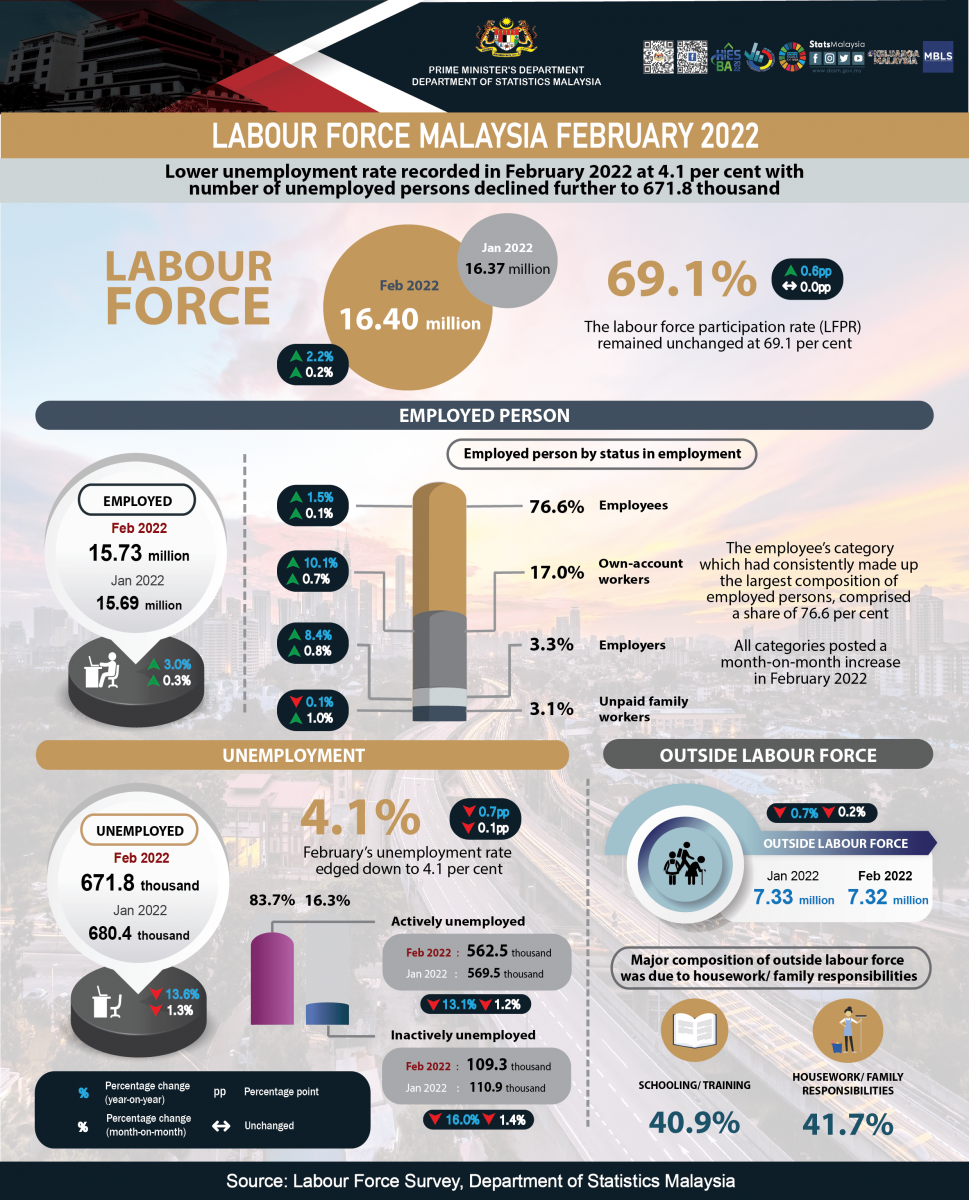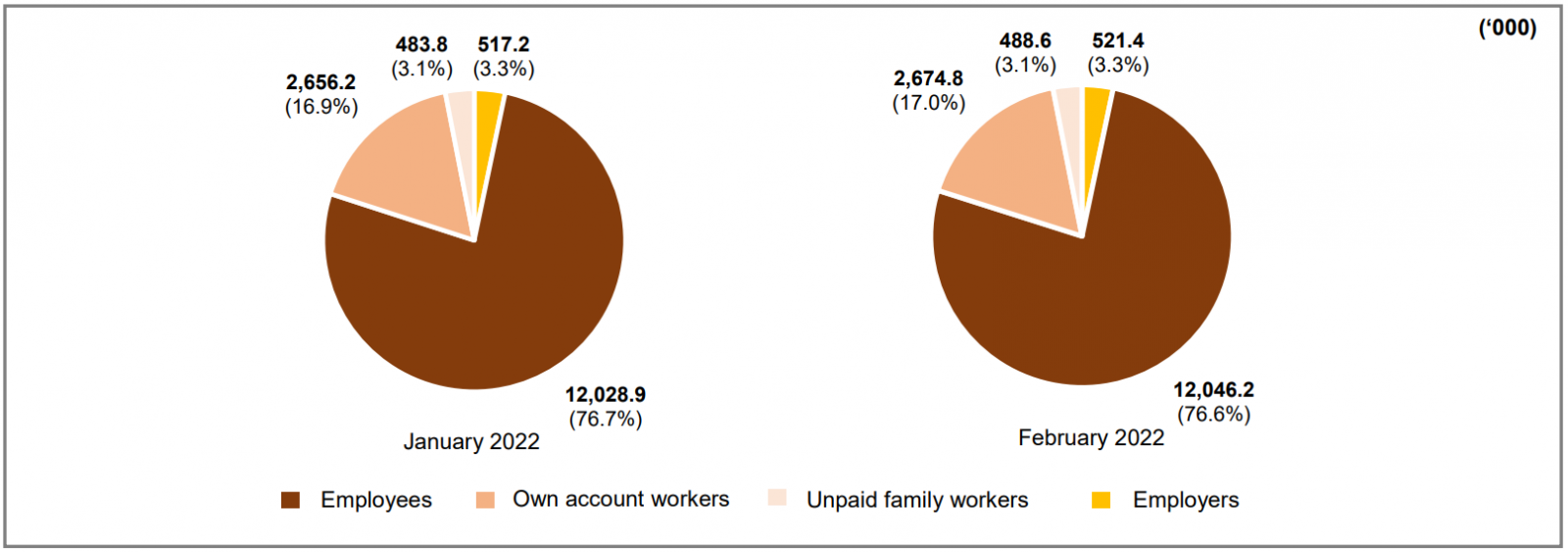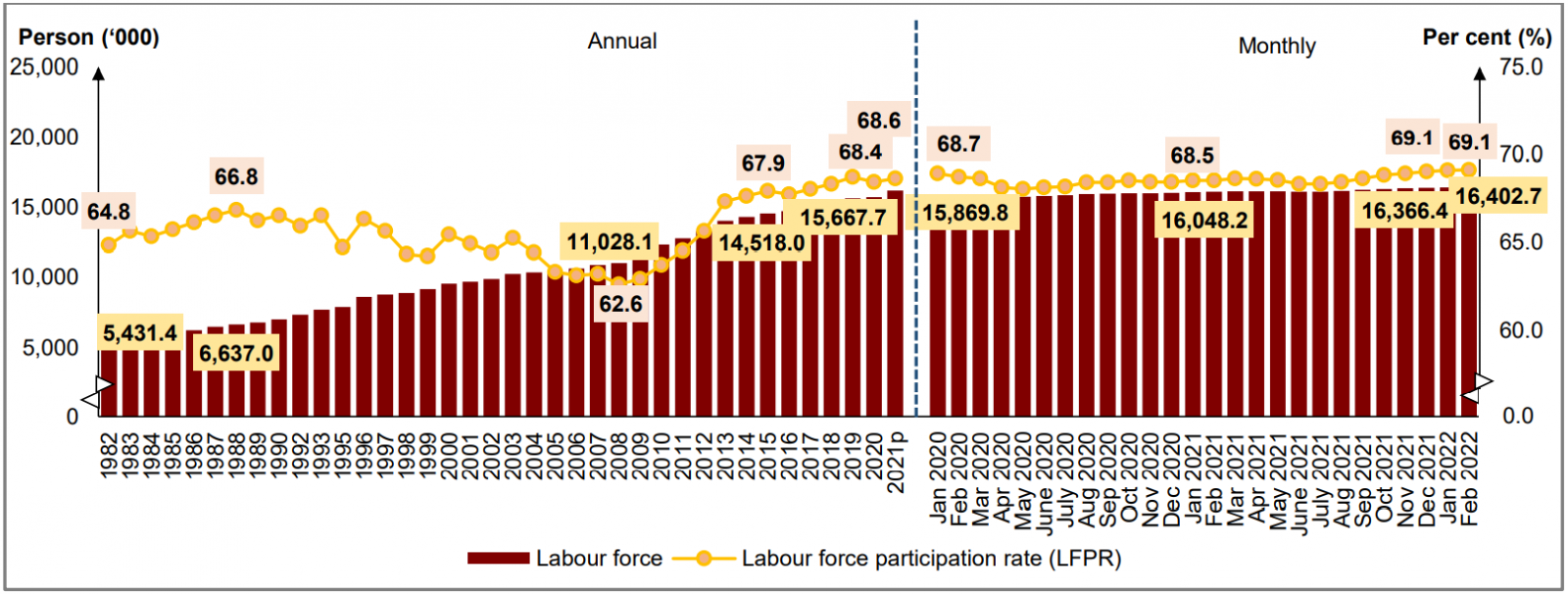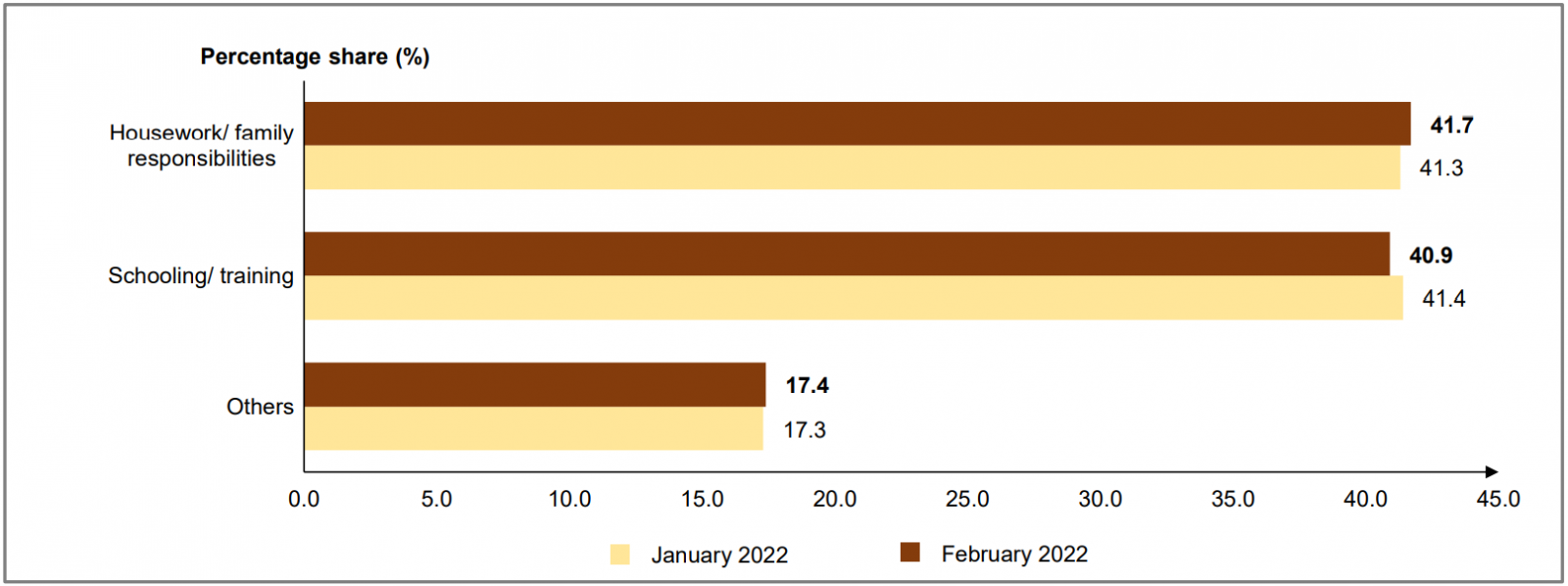Labour Force
- Home
- Statistics
- Labour Market
- Labour Market Information
- Labour Force
Key Statistics of Labour Force in Malaysia, February 2022
Key Statistics of Labour Force in Malaysia, January 2022 8 February 2022
Principal Statistics of Labour Force, Malaysia, Fourth Quarter (Q4) 2021 8 February 2022
Key Statistics of Labour Force in Malaysia, December 2021 10 January 2022
Key Statistics of Labour Force in Malaysia, November 2021 8 December 2021
Key Statistics of Labour Force in Malaysia, October 2021 9 November 2021
Key Statistics of Labour Force in Malaysia, September 2021 Show all release archives
Overview


KEY REVIEWS
- The continuous improvement in employed persons remained in February 2022 with a month-on-month increase of 0.3 per cent (+44.8 thousand people) to post 15.73 million persons (January 2022: 15.69 million persons). During the month, the employment-to-population ratio which indicates the ability of an economic to create employment edged up by 0.1 percentage point to record 66.3 per cent as compared to the previous month (January 2022: 66.2%).
- By looking at the economic sector, the increase in the number of employed persons in Services sector persisted largely in Food & beverages services, Wholesale & retail trade; and Transportation & storage activities. Likewise, the number of employment in Manufacturing and Construction sectors also registered increases. In contrast, Agriculture and Mining & quarrying sectors continued to record a reduction in number of employed persons.
- In February 2022, the employee’s category which had consistently made up the largest composition of employed persons, comprised a share of 76.6 per cent, registering a month-on-month rise of 0.1 per cent (+17.3 thousand persons) to 12.05 million persons (January 2022: 12.03 million persons). Similar trend was observed in the own-account workers category which remained increasing with an addition of 0.7 per cent (+18.6 thousand persons) to register 2.67 million persons (January 2022: 2.66 million persons).
- In February 2022, the number of unemployed persons continued to fall by 1.3 per cent (-8.6 thousand persons) to record 671.8 thousand persons as against January 2022 (680.4 thousand persons). Accordingly, February’s unemployment rate edged down to 4.1 per cent (January 2022: 4.2 per cent).
- In February 2022, the number of labour force continued to register month-on-month increase, rising by 0.2 per cent (+36.3 thousand persons) to 16.40 million persons (January 2022: 16.37 million persons). The labour force participation rate (LFPR) remained unchanged at 69.1 per cent.
- During the month, the number of persons outside labour force remained on a decreasing trend with a reduction of 11.4 thousand persons (-0.2%) to register 7.32 million persons (January 2022: 7.33 million persons). The major composition of outside labour force was due to housework/ family responsibilities with 41.7 per cent and subsequently 40.9 per cent was due to schooling/ training category.
- The recovering economic situation in the first two months of 2022 was driven by encouraging economic activity. This situation allows the economic and business activities to continue operating, leading to more labour demand in the market to accommodate the needs of business operations. This situation gives a positive signal to the labour market, thus encouraging more inclusion in the labour market and enabling the labour market to remain strong for the months to come. Additionally, effective from 1 April 2022, the country was in the transition to the endemic phase with the opening of international borders, physical distancing for jemaah prayers was removed, plus the operating hours restriction for businesses and others was lifted. Therefore, it encourages more international travel activities to take place and it helps to revitalise the country's tourism sector as well as tourism-related activities. The reopening of the country's borders is also seen as a catalyst to revive the shortage of foreign labour in the country.
LABOUR FORCE SITUATION STRENGTHENED IN FEBRUARY 2022 PROMPTED BY THE CONTINUOUS OPERATION OF ALL ECONOMIC AND SOCIAL ACTIVITIES DURING THE MONTH
During the second month of 2022, even though the daily new COVID-19 cases continued to increase, the businesses remained operating as usual with compliance to the standard operating procedures (SOPs), as the country initiated moves to either ease the COVID-19 restrictions or lift them altogether. Globally, given that the virus has a long way to go, countries including Malaysia are learning to live with the COVID-19 virus since it shows no sign of going away, while continuing to battle against its impact and influences on the economy and social activities as well as the labour market along with the daily life.
Therefore, in Malaysia the continuous operation of all economic and social activities in February 2022 has prompted the labour force to continue to strengthen further during the month. As more business activities resumed, it will demand more manpower for operational purposes, thus allowing more creation of job opportunities in the market to sustain the businesses. This situation is seen to have encouraged more labour to enter the labour market.
This is reflected by the ever-increasing growth rate of the employed persons as well as the reduction in the number of unemployment which subsequently resulted in lower unemployment rate during the month. Therefore, a vibrant labour force situation was observed in February 2022. In the meantime, the Leading Index (LI) which indicated the direction of the Malaysian economy remained above 100.0 points and signalled a slower economic momentum in the upcoming months (January 2022: 110.1 points). Nevertheless, in comparison to January 2022, the monthly external trade indicators for both export and import decreased by 7.9 per cent (January 2022: -10.3%) and 10.8 per cent (January 2022: -0.4%) respectively.
Continuous improvement in employed persons remained in February 2022
The continuous improvement in employed persons remained in February 2022 with a month-on-month increase of 0.3 per cent (+44.8 thousand people) to post 15.73 million persons (January 2022: 15.69 million persons). As for the year-on-year comparison, the number of employed persons rose by 3.0 per cent or with an addition of 460.3 thousand persons (February 2021: 15.27 million persons).
By looking at the economic sector, the increase in the number of employed persons in Services sector persisted largely in Food & beverages services, Wholesale & retail trade; and Transportation & storage activities. Likewise, the number of employment in Manufacturing and Construction sectors also registered increases. In contrast, Agriculture and Mining & quarrying sectors continued to record a reduction in the number of employed persons.
During the month, the employment-to-population ratio which indicates the ability of an economy to create employment edged up by 0.1 percentage point to record 66.3 per cent as compared to the previous month (January 2022: 66.2%). Similarly, the ratio went up by 1.1 percentage points year-on-year as against the same month of the previous year (February 2021: 65.2%). [Chart 1]
Chart 1: Employed persons and employment-to-population ratio, January 2018 - February 2022

In February 2022, the employee’s category which had consistently made up the largest composition of employed persons, comprised a share of 76.6 per cent, registering a month-on-month rise of 0.1 per cent (+17.3 thousand persons) to 12.05 million persons (January 2022: 12.03 million persons). Similar trend was observed in the own-account workers category which remained increasing with an addition of 0.7 per cent (+18.6 thousand persons) to register 2.67 million persons (January 2022: 2.66 million persons). This category consists mostly of daily income earners working as small business operators such as retailers; hawkers; sellers in markets and stalls; as well as smallholders. [Chart 2]
Chart 2: Employed person by status in employment, January and February 2022

During the month, the number of employed persons who were temporarily not working continued to decline by registering a reduction of 4.8 per cent (-4.5 thousand persons) to 89.0 thousand persons as compared to the previous month (January 2022: 93.5 thousand persons). Year-on-year, this category remained falling with a decrease of 61.8 thousand persons (February 2021: 150.8 thousand persons). This group of persons, who were most likely not able to work were not categorised as unemployed as they had work to return to.
February’s unemployment rate edged down to 4.1 per cent
In February 2022, the number of unemployed persons declined further by 1.3 per cent (-8.6 thousand persons) to record 671.8 thousand persons as against January 2022 (680.4 thousand persons). Accordingly, February’s unemployment rate edged down to 4.1 per cent (January 2022: 4.2 per cent).
Year-on-year comparison, the number of unemployed persons declined by 105.7 thousand persons or 13.6 per cent (February 2021: 777.5 thousand persons). In the meantime, the unemployment rate dropped by 0.7 percentage points as compared to 4.8 per cent in February 2021. [Chart 3]
Chart 3: Unemployed persons and unemployment rate, 1982 - 2021p and January 2020 - February 2022

By unemployment category, the actively unemployed or those who were available for work and were actively seeking jobs comprised 83.7 per cent of the total unemployed persons. The number in this category reduced by 1.2 per cent (-7.0 thousand persons) to record 562.5 thousand persons (January 2022: 569.5 thousand persons). Out of the total actively unemployed, the unemployed persons for less than three months encompassed 56.7 per cent while those who were in long-term unemployment of more than a year made up a share of 7.3 per cent. In the meantime, those who believed that there were no jobs available or inactively unemployed dipped by 1.4 per cent (-1.6 thousand persons) to 109.3 thousand persons (January 2022: 110.9 thousand persons). [Chart 4]
Chart 4: Unemployed category and duration of unemployment, January and February 2022

In February 2022, the unemployment rate for youth aged 15 to 24 years posted a decrease of 0.2 percentage points to 13.0 per cent with the number of unemployed youths lessened by 7.5 thousand persons or 2.1 per cent to record 356.9 thousand persons (January 2022: 364.5 thousand persons). Likewise, the unemployment rate for youth aged 15 to 30 years diminished by 0.2 percentage points to 8.1 per cent, registering lower number of unemployed persons at 513.7 thousand persons (January 2022: 8.3%; 521.8 thousand persons). [Chart 5]
Chart 5: Unemployment rate by selected age groups, 1982 - 2020 and January 2020 - February 2022

LFPR in February 2022 remained unchanged at 69.1 per cent
In February 2022, the number of labour force continued to register month-on-month increase, rising by 0.2 per cent (+36.3 thousand persons) to 16.40 million persons (January 2022: 16.37 million persons). The labour force participation rate (LFPR) remained unchanged at 69.1 per cent.
As compared to February last year, the number of labour force recorded a rise of 354.5 thousand persons or 2.2 per cent (February 2021: 16.05 million persons), subsequently the LFPR climbed by 0.6 percentage points as against 68.5 per cent (February 2021). [Chart 6]
Chart 6: Labour force and LFPR, 1982 - 2021p and January 2020 - February 2022

In February 2022, both male and female registered increases in the number of labour force by recording 10.08 million persons (January 2022: 10.05 million persons) and 6.32 million persons (January 2022: 6.31 million persons) respectively. Subsequently, male LFPR ascended to 82.0 per cent, whereas female LFPR stood at 55.3 per cent. On the year-on-year basis, male LFPR escalated by 1.0 percentage points (February 2021: 81.0%), similar with female LFPR, rose by 0.2 percentage point as compared to 55.1 per cent in February 2021. [Chart 7]
Chart 7: Labour force and LFPR by sex, 1982 - 2020 and January 2020 - February 2022

Major composition of outside labour force was due to housework/ family responsibilities
During the month, the number of persons outside labour force remained on a decreasing trend with a reduction of 11.4 thousand persons (-0.2%) to register 7.32 million persons (January 2022: 7.33 million persons). Similarly, the number of outside labour force dropped by 50.7 thousand persons (-0.7%) year-on-year (February 2021: 7.37 million persons). The major composition of the outside labour force was due to housework/ family responsibilities with 41.7 per cent and subsequently 40.9 per cent was due to schooling/ training category. [Chart 8]
Chart 8: Share of outside labour force by reasons for not seeking work, January and February 2022

GOVERNMENT’S INITIATIVES
The Wage Subsidy Programme (PSU) under the PRIHATIN Packages is a financial aid paid to employers of each enterprise to ensure employees are able to retain their jobs. A total of 322,177 employers and 2.64 million registered employees benefitted through PSU 1.0 with an approved wage subsidy at RM12.96 billion as of 18 March 2022. In addition, a total of RM1.41 billion was distributed to 81,132 employers to continue operating and maintaining a total of 718,195 employees through PSU 2.0 under the Kita PRIHATIN Packages. As for PSU 3.0, a total of 162,255 employers were supported to retain 1.53 million employees involving a total value of RM3.73 billion. Subsequently, RM2.47 billion was channelled to 159,326 employers and 1.87 million employees through PSU 4.0 under PEMULIH packages. Next, through PSU 5.0, a total of RM72.0 million was disbursed to 3,681 employers to retain 61,722 employees.
Additionally, through Malaysia Short-Term Employment Programme (MySTEP), a total of 2,709 participants were successfully positioned in the public sector and GLCs as of 25 March 2022. A total of 1,833 employees were placed in the public sector while 713 employees were successfully placed in the GLCs and their strategic partners. Besides, through the JaminKerja Keluarga Malaysia initiative under SOCSO, 42,014 employees had successfully obtained jobs as of 15 March 2022. Furthermore, through the Reskilling and Upskilling Veteran ATM Programme (PRUV-ATM), a total of 8,736 army veterans had benefitted through this programme. Also, a total of 364 participants from 2,442 applicants under this programme were successfully positioned in the technology and digital services jobs through MyDigitalWorkforce Work in Tech (MYWiT) as of 25 March 2022. This initiative was introduced by the government in collaboration with Malaysia Digital Economy Corporation (MDEC) to improve the skills and capabilities of Malaysian workers by encouraging companies to hire local workers for technology and digital services jobs through salary incentives and training course subsidies.
To empower the businesses, through the SMEs Soft Loan Funds by BNM which comprised of Special Relief Facility (SRF); Automation & Digitalisation Facility (ADF); All-Economic Sector Facility (AES); and Agrofood Facility (AF), a total of 26,379 SMEs was benefitted with a value of RM12.59 billion as of 25 March 2022. Moreover, to support and encourage SMEs and Technical and Digital Mid-tier Companies (MTCs), a total of RM92.3 million was channelled to 13,892 businesses to digitalise their operations and trade channels in the form of grants and loans for digitalisation services subscriptions. Besides, under the Danajamin Prihatin Guarantee Scheme (DPGS), which focused on the viable businesses in all sectors facing difficulties due to the COVID-19, a value of RM2.07 billion of total guarantees had been approved to 60 companies over the 92 companies applying for the guarantees, as of 25 March 2022. Meanwhile, through the Special Business Financing Scheme for Women (DanaNITA) programme under Majlis Amanah Rakyat (MARA), there were 84 women entrepreneurs were assisted involving a total financing value of RM3.35 million as of 28 February 2022.
Meanwhile, through the Indian Community Entrepreneur Development Scheme (SPUMI), which is a strategic initiative under TEKUN designed to assist the Indian community in improving their economy through engagement in business and entrepreneurship, a total of RM21.72 million was channelled to support 902 Micro SMEs as of 25 March 2022. Under the Agrobank Microcredit Financing Scheme which aims to support the Agriculture and Food Industries, a total of 19,381 Agricultural Micro-SMEs has been assisted which involving a total of RM241.17 million funds. In addition, there were 380 approved applications involving financing values of RM76.4 million through the PENJANA Tourism Financing. As for the CENDANA initiative which was designed to support the Arts, Culture and Entertainment Sector, a total of RM7.07 million was funded to 589 recipients including artists and organisations who were actively involved in the Malaysian Arts and Culture industry as of 25 March 2022.
LOOKING AHEAD
The recovering economic situation in the first two months of 2022 was driven by encouraging economic activity. This situation allows the economic and business activities to continue operating, leading to more labour demand in the market to accommodate the needs of the business operations. This situation gives a positive signal to the labour market, thus encouraging more inclusion in the labour market and enabling the labour market to remain strong for the months to come.
As for the current health situation, as of 6 April 2022, a total of 79.2 per cent of the Malaysia’s population are fully vaccinated while the adolescent vaccination rate is 97.6 per cent. In the meantime, COVID-19 vaccination for children aged five to eleven was 36.9 per cent. Additionally, effective from 1 April 2022, the country was in the transition to the endemic phase with the opening of international borders, physical distancing for jemaah prayers was removed, plus the operating hours restriction for businesses and others was lifted. However, the compulsory orders of wearing face masks are still ongoing and the SOPs need to be practised to ensure the country's safe transition to the next phase. Therefore, it encourages more international travel activities to take place and it helps to revitalise the country's tourism sector as well as tourism-related activities. The reopening of the country's borders is also seen as a catalyst to revive the shortage of foreign labour in the country.
TECHNICAL NOTES
This information is derived from the Labour Force Survey (LFS) which was conducted to collect information on the structure and distribution of labour force, employment and unemployment.
The survey population cover persons who live in private living quarters and excludes persons residing in institutions such as hotels, hostels, hospitals, prisons, boarding houses and workers residing in construction work site.
The survey comprises of the economically active and inactive population. To measure the economically active population, the LFS uses the age limit of 15 to 64 years. The economically active population comprises of those employed and unemployed whereas those who are inactive is classified as outside the labour force.
LFS uses the actual status approach, where a person is classified on the basis of his labour force activity during the reference week.
- Labour force refers to those who, during the reference week are in the 15 to 64 years (in completed years at last birthday) and who are either employed or unemployed.
- Employed refers to all persons who, at any time during the reference week worked at least one hour for pay, profit or family gain (as an employer, employee, own-account worker or unpaid family worker). Also considered as employed are persons who did not work during the reference week because of illness, injury, bad weather, leave, labour dispute and social or religious reasons but had a job, farm, enterprise or other family enterprise to return to. Also included are those on temporary lay-off with pay who would definitely be called back to work.
- Unemployed
Unemployed refers to those who do not have a job but are interested to work. There are two groups of unemployed that is the actively unemployed and inactively unemployed.
- Outside Labour Force
All persons not classified as employed or unemployed as stated above are classified as outside labour force. Includes housewives, students (including those going for further studies), retired, disabled persons and those not interested in looking for a job.
- Labour Force Participation Rate
The economic activity of a population depends on the demographic characteristics of that population. The proportion of economically active population, therefore, differs between sub-groups of that population. These variations are measured by specific activity rates termed as labour force participation rate. Labour force participation rate is defined as the ratio of the labour force to the working age population (15 to 64 years), expressed as percentage.
- Unemployment rate is the proportion of unemployed population to the total population in labour force. This rate measures the percentage of unemployed population in the labour force.
Population by characteristics of age group, ethnicity and state were used as benchmarks to produce labour statistics.
Starting with the monthly release of the Principal Statistics of Labour Force, Malaysia, January 2016, the principal statistics of labour is estimated based on the current population estimates as compared to the previous series which used population projections based on the Population and Housing Census of Malaysia, 2010. This rebase is to obtain statistics that is more consistent with current population structure.
The full publication of the Labour Force Report, February 2022 can be downloaded through eStatistik Portal.
For more details, please refer to the Department’s portal: www.dosm.gov.my
Released By:
DEPARTMENT OF STATISTICS, MALAYSIA
08 APRIL 2022
Contact person:
Mohd Yusrizal bin Ab. Razak
Public Relation Officer
Strategic Communication and International Division
Department of Statistics, Malaysia
Tel : +603-8885 7942
Fax : +603-8888 9248
Email : yusrizal.razak@dosm.gov.my
Subscribe
Newsletter
Subscribe to our newsletter and stay updated
For interviews, press statement and clarification to the media, contact:
Baharudin Mohamad
Public Relation Officer
Email: baharudin[at]dosm.gov.my
Phone: 03 8885 7942
Not found what you looking for? Request data from us, through
Go to eStatistik
email to data[at]dosm.gov.my
call 03 8885 7128 (data request)









